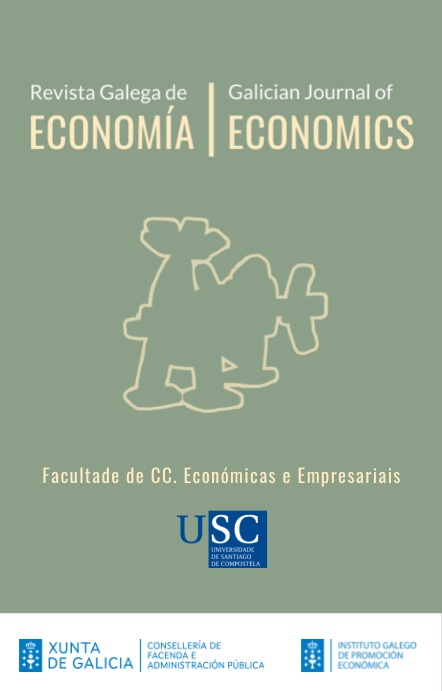Proxeccións de poboación para áreas pequenas: estimacións no ámbito da parroquia en cinco provincias do noroeste de España
Contido principal do artigo
Resumo
Neste artigo preséntase un procedemento sinxelo para obter proxeccións demográficas para áreas xeográficas pequenas. O método aquí presentado baséase en asumir que as tendencias das zonas que se van proxectar serán similares ás observadas en períodos anteriores, e en tomar as proxeccións para áreas xeográficas máis extensas como punto de referencia. En termos matemáticos, esta técnica pasa por un problema de minimización restrinxida das diverxencias cuadráticas entre as proxeccións obtidas e as observadas en períodos pasados, onde as proxeccións demográficas agregadas se toman como restrición.
Esta proposta encaixa adecuadamente co escenario presente no caso das proxeccións demográficas que o Instituto Nacional de Estatística (INE) elabora para España, onde as previsións se presentan a escala provincial pero non con máis nivel de detalle. Aínda que estas proxeccións provinciais son útiles de cara á planificación de políticas e de cara á dotación de determinados servizos por parte do sector público, sería desexable dispor delas a unha escala xeográfica inferior ao do ámbito provincial. O procedemento presentado neste traballo ilústrase co caso de cinco provincias de España, correspondentes ás comunidades autónomas de Asturias e Galicia, nas que as predicións de poboación correspondentes para o ano 2033 son desagregadas a unha escala xeográfica de parroquia.
Palabras chave
Detalles do artigo
Citas
Alonso, M.L., Fernández Vázquez, E., y Rubiera, F. (2015). A methodological note for local demographic projections: A shift-share analysis to disaggregate official aggregated estimations. Rect@: Revista Electrónica de Comunicaciones y Trabajos de ASEPUMA, 16(1), 43-50. Recuperado de: https://dialnet.unirioja.es/servlet/articulo?codigo=5601444
European Commission. (2020). Global Human Settlement Layer (GHSL). Brussels, Belgium: European Commission. Research Group, Joint Research Center. Recuperado de: https://ec.europa.eu/jrc/en/global-human-settlement-layer
Dunn, E. S. (1960). A statistical and analytical technique for regional analysis. Papers of the Regional Science Association, 6, 97-112. DOI: https://doi.org/10.1111/j.1435-5597.1960.tb01705.x
Glaeser, E.L., Kourtit, K., y Nijkamp, P. (2020). Urban empires: Cities as global rulers in the new urban world. New York, NY: Routledge.
Glaeser, E.L., Ponzetto, G. A. M., y Tobio, K. (2014). Cities, skills and regional change. Regional Studies, 48(1), 743. DOI: https://doi.org/10.1080/00343404.2012.674637
Gutiérrez, D., Rubiera, F., y Viñuela, A. (2017). Heterogeneity in the determinants of the population growth at the local level. Analysis of the Spanish case with GWR approach. International Regional Science Review, 40 (3), 211-240. DOI: https://doi.org/10.1177/0160017615589009
King, G., Rosen, O., y Tanner, M.A. (2004). Ecological inference: New methodological strategies. Cambridge, UK: Cambridge University Press. DOI: http://doi.org/10.1017/CBO9780511510595
Mayor, M., López, A. J., y Pérez, R. (2007). Forecasting regional employment with shift-share. Regional Studies, 41 (4), 543-551. DOI: https://doi.org/10.1080/00343400601120205
Mazzuco, S., y Keilman, N. (Eds.). (1990). Developments in demographic forecasting.The Springer Series on Demographic Methods and Population Analysis, 49. Cham, Switzerland: Springer. DOI: https://doi.org/10.1007/978-3-030-42472-5
Rubiera, F., Fernández, E., Gutiérrez, D., y Viñuela, A. (2014). Análisis de la situación y perspectivas demográficas en el Principado de Asturias y revisión de las políticas aplicadas en Europa para el diseño de una agenda demográfica. Primer informe del diagnóstico de la situación y perspectivas demográfricas del Principado de Asturias. Oviedo: Laboratorio de Análisis Económico y Regional -REGIOlab.
Artigos máis lidos do mesmo autor/a(s)
- André Carrascal-Incera, Esteban Fernández Vázquez, Mònica Serrano Gutiérrez, COVID-19 e os seus efectos económicos: rupturas nas cadeas de valor e cambios nos patróns de consumo , Revista Galega de Economía: Vol 30 No 1 (2021): Número Extraordinario. COVID-19 e os seus efectos económicos: Rupturas nas cadeas de valor e cambios nos patróns de consumo







